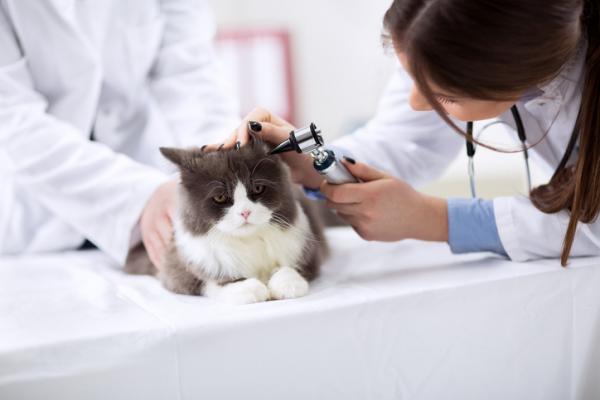Common diseases in the ears of cats

Each animal has characteristics that help it to develop in the different environments in which it lives. Cats, in addition to excellent vision, have an acute hearing. However, the ear and ears can suffer various conditions, worsening this capacity and endangering the health of the feline.
In this article we will talk about the most common diseases in the ears of cats. Keep reading!
Diseases in the ears of cats: otitis
Is a inflammation of the epithelium, inner tissue of the ear that is responsible for protecting the auditory organ of external microorganisms, as well as for secreting substances. Otitis is a common disease in the ears of very painful cats that can generate temporary loss of hearing.
Their causes They are diverse, from Mites y bacteria but also mushrooms or foreign bodies that have entered the auditory cavity, among others. If your cat suffers from otitis, it will scratch frequently, Shake your head and will complain with constant meowing. The treatment most common for otitis in cats are the Antibiotics, so that the veterinarian will prescribe the most appropriate depending on the cause of the disease.

Diseases in the ears of cats: feline notoedric mange
This type of scabies affects both the ears and other parts of the feline’s body. It is caused by the mite Notoedres cati, that nests in the skin of the cat, especially in the head.
Nooedric mange causes irritation intense in the ears, causing the cat to scratch very often, in addition to redness, restlessness and even wounds by scratching continuously. Topical treatment is the most common for these cases, although the use of pipettes, shampoo, or injectable medications is also recommended.
Diseases in the ears of cats: dermatophytosis
La dermatophytosis, Also known as tub, is a disease caused by dermatophytes, a type of fungus that normally affects the head, legs and ears of cats. It is very common in young cats, especially those that are less than one year old and in those with long fur.
Between the symptom of this common disease in the ears of cats stands out the pruritus, Plus hairless areas y circular lesions in the affected body parts. Although the disease can disappear spontaneously, it is highly contagious for both animals and people, so it is recommended to attack it as soon as possible. As a treatment, ointments or creams are applied, as well as oral medicines in the most serious cases. See the article “Tinea in cats – contagion and treatment” for more information.

Diseases in the ears of cats: solar dermatitis
It is a disease caused by a constant and prolonged exposure to the sun. It appears in cats whose levels of melanin in the coat are reduced, revealing a light color. Solar dermatitis is characterized by the appearance of scabs y ulcers, scaly skin on the ears, so if your cat has scabs on the ears and wounds, this may be the cause. In extreme cases, tumors may appear. Also, it provokes pain y itch, so the cat will scratch frequently, causing injuries.
As a treatment, it is recommended to suspend sun exposure immediately and place creams and ointments on the affected areas. In severe cases, surgery may be necessary.
Diseases in the ears of cats: pemphigus foliaceus
It is a autoimmune disease that attacks the feline’s head, especially its ears. An autoimmune disease is one in which the body of the affected animal destroys itself, since it does not differentiate between good or bad cells.
If your cat suffers from this disease, it will present pustules, sores y loss of furAlso itching, discomfort, lethargy y fever. It is very difficult to treat and can cause death if not treated in time. The treatment includes from the application of ointments in the affected areas, accompanied by corticosteroids, immunosuppressants, biological therapies, antibiotics, among other methods.
Diseases in the ears of cats: lupus erimatoso discoidea
Like foliaceous pemphigus, it is a autoimmune disease It attacks the skin, concentrating mainly on the head, where it affects the nose, eyes and ears.
It is possible to detect it due to the injuries it causes, because it leaves open woundsIn addition to loss of coloration in the affected area. It is also appreciated fall of the coat y ulcers. There is no treatment that completely eliminates the disease, so the veterinarian will focus on reducing the conditions and symptoms. In general, immunosuppressants, antibiotics and topical treatments are used to reduce the ailments suffered by the feline.
Diseases in the ears of cats: otohematoma
It is a disease that affects the auditory pavilions of the cat’s ears. It can be caused by sudden shaking of the head of the animal or by scratching very energetically, which accumulates blood in the pavilions, which end up inflamed. There are two treatments: the application of anti-inflammatories and surgery.
General recommendations for caring for the cat’s ears
It is very important to maintain proper care in the cat’s ears, as this prevents the appearance of these diseases. For this, we recommend making a Periodic revision to the outside of the ears to detect any infection, inflammation, foreign secretions or even objects that may have penetrated the cavity.
For cleanings, it is best to go to the vet, he will administer them without there being any risk of damaging your cat’s ear canal. However, in the article “Cleaning the ears of a cat step by step” you will find a basic guide. Of course, never apply medications without medical supervision, or sprinkle water or other liquid on the ears of your cat without the recommendation of a specialist. Keep in mind that many of the common diseases in the ears of cats described are serious and even some do not have treatment, so prevention is the key.

This article is merely informative, in .com we do not have the faculty to prescribe veterinary treatments or make any kind of diagnosis. We invite you to take your pet to the veterinarian in case of any type of condition or discomfort.
If you want to read more articles similar to Common diseases in the ears of cats, we recommend that you enter in our Prevention section.


